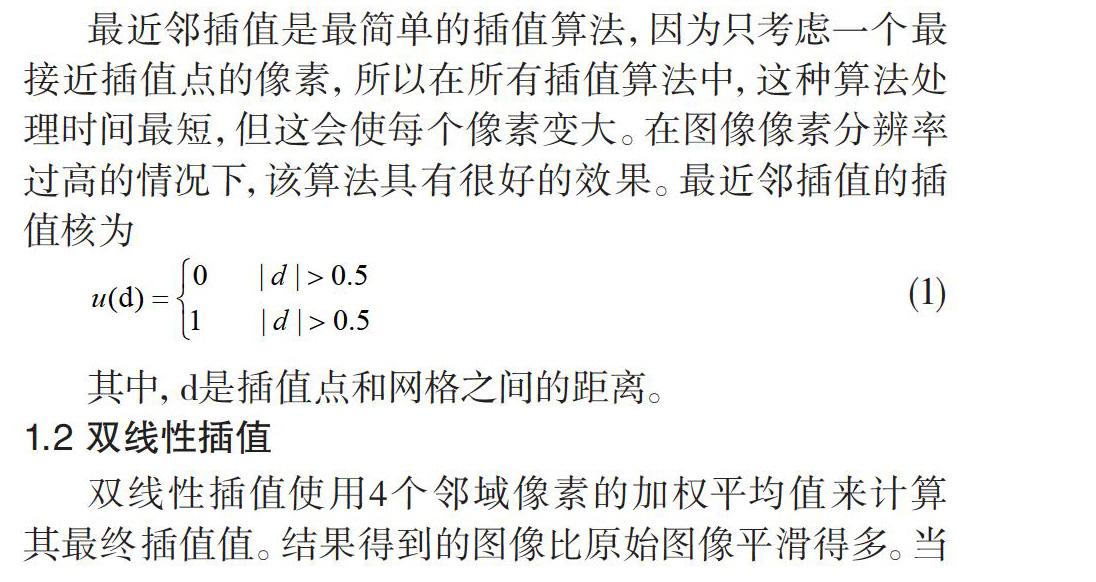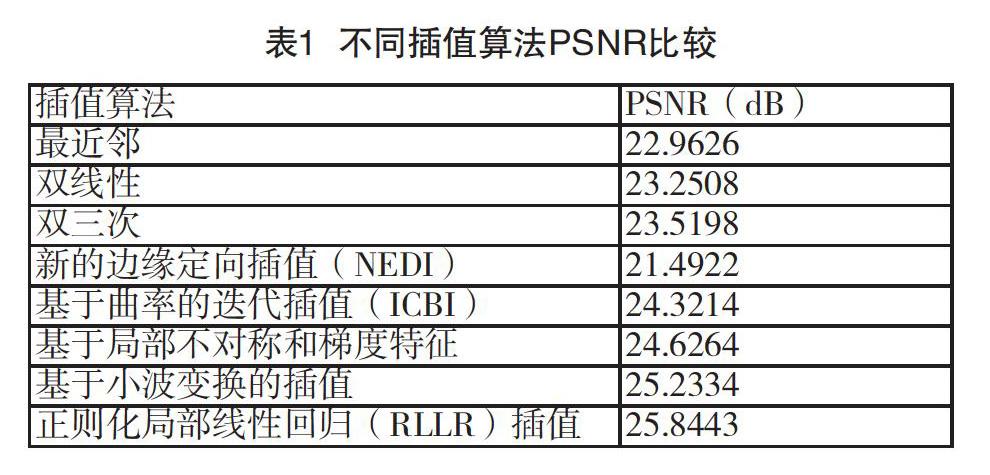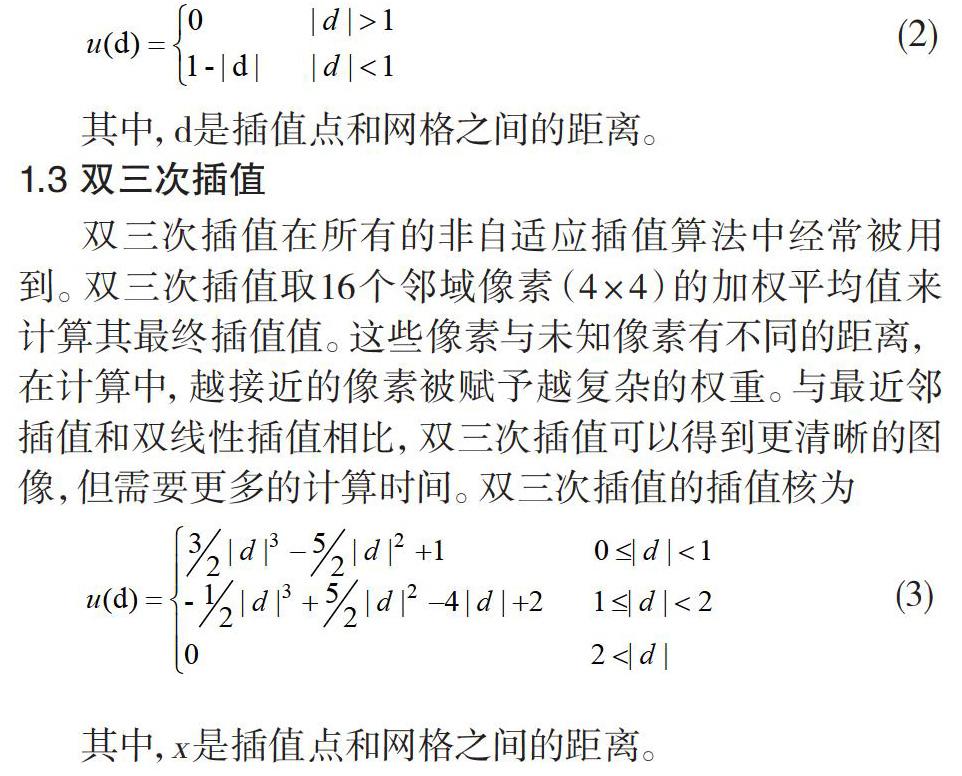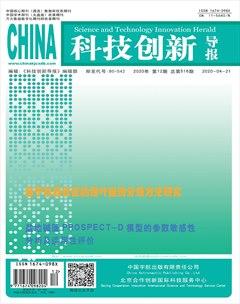自适应与非自适应图像插值算法比较分析
陈浩 郭欣欣



摘 要:图像插值是从已知像素值计算未知像素值的过程,可用于数字图像的放大和对比。图像插值技术在遥感、医学诊断、农业、地质、军事等众多领域都有着广泛的应用。有多种算法可用于图像缩放,这些技术主要分为自适应和非自适应图像插值两类,这两种插值技术可进一步分为各种类型。本文从峰值信噪比(PSNR)这一性能参数出发,对这些不同的自适应和非自适应图像插值技术进行了阐述和比较。选择合适的插值方法是一项非常严谨的研究,也是进行插值分析的首要要求。
关键词:图像插值 非自适应 自适应 峰值信噪比
中图分类号:TP391 文献标识码:A 文章编号:1674-098X(2020)04(c)-0128-03
Abstract: Image interpolation is the process of calculating unknown pixel values from known pixel values, and can be used to zoom in and compare digital images. Image interpolation technology has been widely used in many fields such as remote sensing, medical diagnosis, agriculture, geology, and military. There are a variety of algorithms available for image scaling. These techniques are mainly divided into adaptive and non-adaptive image interpolation. These two interpolation techniques can be further divided into various types. Based on the performance parameter of PSNR, this paper describes and compares these different adaptive and non-adaptive image interpolation algorithms. Choosing a suitable interpolation method is a very rigorous study and the first requirement for interpolation analysis.
Key Words: Image interpolation; Non-adaptive; Adaptive; PSNR
图像插值在图像处理领域有着广泛的应用,比如可以应用于计算机图形学、绘制、编辑、医学图像构建和轮廓图像查看等各个领域。图像插值就是在不丢失原始图像的视觉信息的情况下,从原始低分辨率图像分辨率生成另外一个高分辨率分辨率的图像[1]。图像缩放是将图像从一个比例转换为另一个比例的过程,而插值是一个图像放大的过程,这个过程是通过在离散输入样本区间的值拟合一个连续函数来实现[2]。图像放大技术已广泛应用于计算机设备、打印机、数字电视、媒体播放器等领域。另一方面,图像缩小技术在应用中也很有用,例如将高分辨率图像转换为低分辨率图像,以适应小型液晶显示系统。图像插值是数字图像处理中一个具有挑战性的重要问题。
插值算法可分为自适应和非自适应两类。非自适应算法将固定模式应用于每个像素,而不考虑其他参数作为图像的特征、边缘。这种插值技术可能会在插值图像中产生锯齿效应等[2]。自适应算法利用邻域像素的光谱和空间特征,使未知像素尽可能接近原始像素。为了获得高质量的图像,人们开发了空间和光谱相关技术。根据相邻像素的特征,预测新像素的值,使其更有效地插值。在自适应插值技术中减少或消除了锯齿效应。但是,一些自适应插值技术可能需要更多的时间来转换图像,因此有时它可能无法应用于实时应用。插值方法有两空域插值和频域插值[3]两种。近年来,空间域技术因其复杂度低而被应用于实时应用中。另一种方法使用各种变换,如离散余弦变换(DCT)、离散傅立叶变换(DFT)或小波变换在频域中缩放图像。频域技术获得了更高的复杂度和存储需求,因此不适合实时或低成本的应用。使用现场可编程门阵列(FPGA)或专用集成电路(ASIC)可以实现这些插值技术[2]。
1 非自适应图像插值算法
在各种提出的实现图像缩放的非自适应插值算法中,主要有最近邻、双线性、双三次图像插值等。最简单的是最近邻算法,时间复杂度低,并且比较容易实现[4]。使用此算法创建的图像包含块化和锯齿化算法,为了减少这种阻塞和混叠效应,最常用的方法是双线性算法,该算法使用线性插值模型来计算未知像素。双三次插值是比较复杂但更精确的方法,通过二维规则网格的加权和插值圖像像素,可以得到高质量的图像[5]。
1.1 最近邻插值
最近邻插值是最简单的插值算法,因为只考虑一个最接近插值点的像素,所以在所有插值算法中,这种算法处理时间最短,但这会使每个像素变大。在图像像素分辨率过高的情况下,该算法具有很好的效果。最近邻插值的插值核为
自適应插值方法在图像视觉质量方面得到了提升,但它需要更多的计算投入。当时间不是决定性因素时,我们一般选择自适应策略,但非自适应策略更简单。所以,在实际应用中,根据不同的图像处理对象,选择不同的插值算法。
参考文献
[1] Mahajan S H , Harpale V K . Adaptive and Non-adaptive Image Interpolation Techniques [C]// Computing Communication Control and Automation Conference(ICCUBEA), 2015 IEEE. IEEE, 2015.
[2] Jaiswal S P , Jakhetiya V , Kumar A , et al. A low complex context adaptive image interpolation algorithm for real-time applications[C]// Instrumentation and Measurement Technology Conference (I2MTC), 2012 IEEE. IEEE, 2012.
[3] 高翔. 基于DCT域的图像插值技术研究[D].哈尔滨工业大学,2012.
[4] Patel V, Mistree K. A Review on Different Image Interpolation Techniques for Image Enhancement[J]. International Journal of Emerging Technology and Advanced Engineering, 2013, 3(12):129-133
[5] Yunshan Zhang, Yuhui Li, Jie Zhen, Jionghao Li, Ran Xie. The Hardware Realization of the Bicubic Interpolation Enlargement Algorithm Based on FPGA[P]. Information Processing (ISIP), 2010 Third International Symposium on,2010.
[6] Wang Xiuhua,Jia Xinyue,Zhou Wei,Qin Xiaoyun,Guo Hanming. Correction for color artifacts using the RGB intersection and the weighted bilinear interpolation.[J]. Applied optics,2019,58(29).
[7] Lee J H , Kim J O , Han J W , et al. Edge-Oriented Two-Step Interpolation Based on Training Set[J]. IEEE Transactions on Consumer Electronics, 2010, 56(3):1848-1855.
[8] Chen S L . VLSI Implementation of an Adaptive Edge-Enhanced Image Scalar for Real-Time Multimedia Applications[J]. IEEE Transactions on Circuits and Systems for Video Technology, 2013, 23(9):1510-1522.
[9] Karpagam A V , Manikandan M . Interpolation tool: Qualitative and quantitative analysis for machine vision applications[C]// Fourth International Conference on Signal Processing. IEEE, 2017.
[10]Hwamog Kim, Jeffrey L. Willers, Seongjai Kim. Curvature Interpolation Method for Surface Reconstruction for Geospatial Point Cloud Data[J]. International Journal of Remote Sensing, 2019:1-30.
[11]房琰. 基于梯度轮廓和非局部自相似性的单幅图像超分辨率方法研究[D].山东大学,2019.
[12]Zhu S, Zeng B, Zeng L, et al. Image Interpolation Based on Non-local Geometric Similarities and Directional Gradients[J]. IEEE Transactions on Multimedia, 2016, 18(9):1-1.
[13]Dong W, Shi G, Xu J. Adaptive Nonseparable Interpolation for Image Compression With Directional Wavelet Transform[J]. IEEE Signal Processing Letters, 2008(15):233-236.
[14]汪成峰. 基于自适应关节权重和插值小波的体感动作评价方法研究[D].中国农业大学,2016.
[15]李小燕. 基于广义图像先验的图像超分辨率重建算法研究[D].西南交通大学,2015.
[16]Liu X , Zhao D , Xiong R , et al. Image Interpolation Via Regularized Local Linear Regression[J]. IEEE Transactions on Image Processing, 2012, 20(12):3455-3469.

